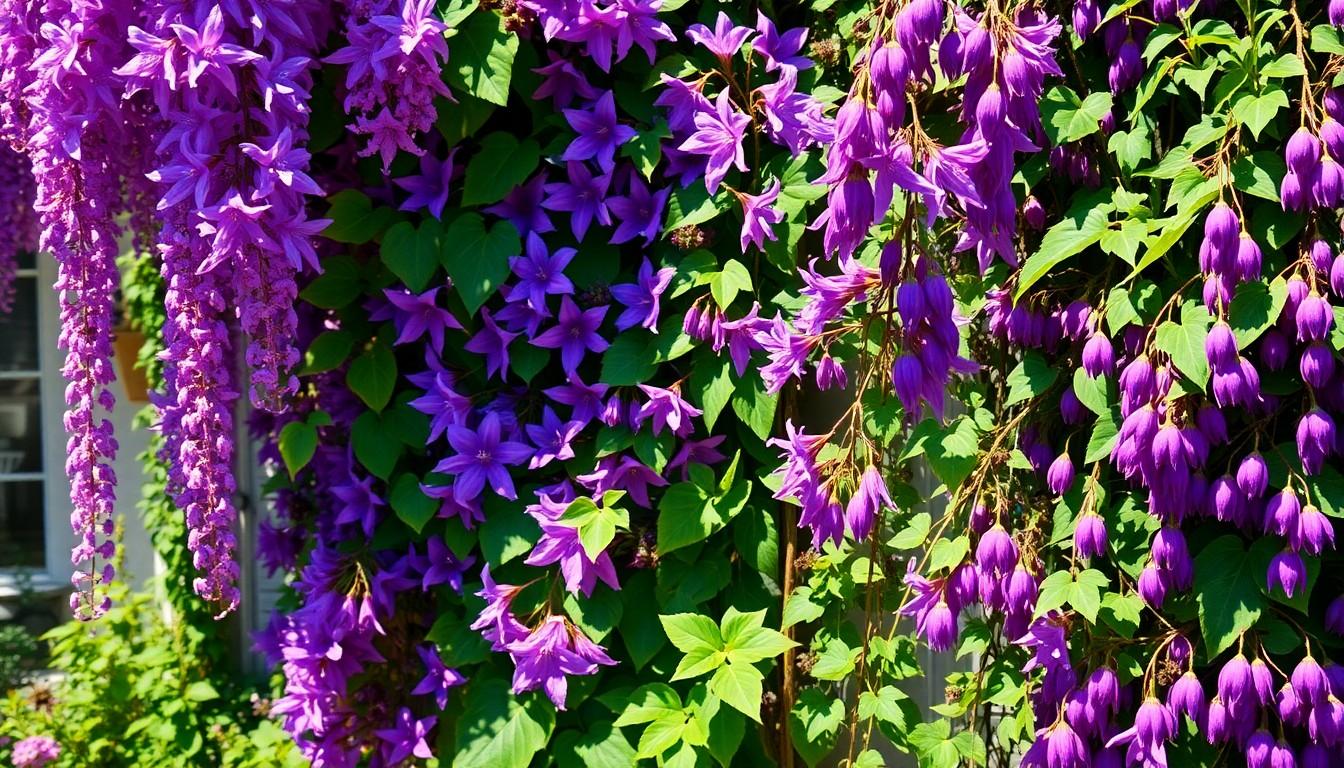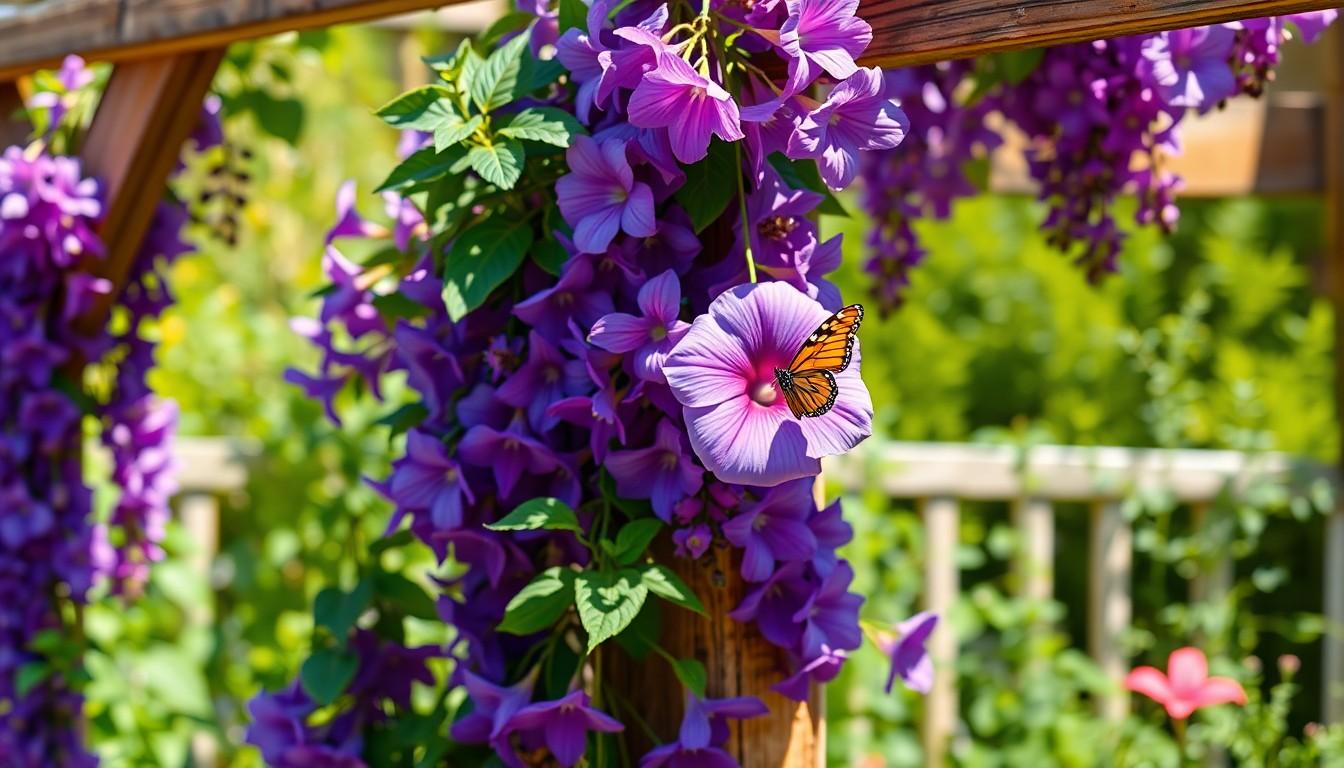When it comes to adding a splash of color to any garden or outdoor space, few things can compete with the charm of vines adorned with purple flowers. These climbing wonders not only bring a vibrant hue to fences and trellises but also have a knack for stealing the spotlight from the more mundane greenery. Imagine walking into your yard and being greeted by a cascade of stunning purple blooms—it’s like nature’s own confetti party!
But don’t be fooled by their delicate appearance; these vines are tough cookies, thriving in various conditions while requiring minimal upkeep. From the whimsical wisteria to the enchanting purple morning glory, there’s a vine for every garden enthusiast. So, whether you’re looking to impress the neighbors or simply want to brighten your outdoor sanctuary, it’s time to embrace the magic of purple-flowered vines. Who knew gardening could be this fun and fabulous?
Overview of Vines With Purple Flowers
Vines with purple flowers thrive in various climates and conditions, making them versatile in garden design. Wisteria, known for its cascading clusters, produces fragrant blooms that attract pollinators. Morning glory, with its heart-shaped leaves, opens its vibrant flowers in the morning, adding a pop of color to any space.
Several other cultivars enrich the landscape as well. Clematis features a range of purple shades and diverse bloom shapes, appealing to many garden enthusiasts. Hyacinth bean vine not only offers beautiful purple flowers but also decorative pods that continue the aesthetic appeal post-bloom.
Growth habits differ among these vines. Some species, like trumpet vine, exhibit aggressive growth, while others prefer a gentler climb, such as sweet pea. Gardeners can select species based on the available space and desired maintenance level.
Purple-flowered vines can serve multiple purposes. They work well on trellises, fences, and arbors, creating natural privacy screens. Additionally, they can enhance vertical garden designs, maximizing limited space for growing.
Integrating these vibrant vines with complementary plants enhances garden aesthetics. Pairing purple flowers with yellow or white blooms provides striking contrast and visual interest. The resultant displays captivate the eye, creating unforgettable outdoor experiences.
Habitats and care needs vary among species. Most purple-flowered vines require sunlight for optimal growth, generally thriving in full sun to partial shade. Soil quality also plays a significant role; well-draining soil fosters successful growth, while poor drainage can lead to root rot.
These stunning climbing plants not only partake in beautifying gardens but also support local ecosystems by attracting bees, butterflies, and other beneficial insects. Exploring the options among purple-flowered vines offers exciting opportunities for garden enthusiasts seeking to enhance their outdoor spaces.
Popular Types of Vines With Purple Flowers

Several enchanting vines showcase striking purple flowers, providing stunning options for gardeners. Each type brings unique features that can transform outdoor spaces.
Wisteria
Wisteria stands out for its cascading clusters of purple blooms. With a vigorous growth habit, it can reach over 30 feet high. Gardeners value this vine for its fragrant flowers that attract pollinators. It thrives in full sun and well-drained soil, making it ideal for trellises and pergolas. Some varieties, such as Japanese wisteria, can exhibit aggressive growth, requiring regular pruning to manage their size.
Clematis
Clematis offers diverse varieties with striking purple flowers, ranging from deep violet to lavender shades. This vine grows well in various climates and adapts to different soil types. Some clematis varieties climb gently, making them suitable for smaller spaces or container gardening. They benefit from partial to full sun exposure and appreciate a good mulch layer for moisture retention. Blooms appear in spring or summer, showcasing their beauty throughout the growing season.
Purple Hyacinth Bean
Purple Hyacinth Bean captivates with its lush foliage and vibrant purple flowers. This annual vine can reach up to 10 feet in length, offering a quick-growing option for gardeners. Flowers attract butterflies, enhancing garden appeal while providing ecological benefits. It thrives in full sun and poor soil, demonstrating remarkable adaptability. Additionally, the decorative seed pods develop in late summer, adding visual interest long after the blooms fade.
Growing Conditions for Purple Flowering Vines
Purple flowering vines thrive under specific conditions to reach their full potential. Understanding these requirements helps garden enthusiasts cultivate vibrant and healthy plants.
Soil Requirements
Soil quality plays a critical role in the growth of purple flowering vines. Well-draining soil is essential to prevent root rot. Clay or compacted soils hinder drainage, so amending soil with organic matter improves texture. A pH level between 6.0 and 7.0 suits most vines, providing balanced nutrient availability. Wisteria and clematis often prefer slightly acidic to neutral soil. Morning glory adapts to less ideal soil conditions, making it a versatile choice. Regular soil testing ensures that nutrients remain in check and allows for successful growing results.
Sunlight and Water Needs
Sunlight affects the blooming and growth of purple flowering vines significantly. Most prefer 6 to 8 hours of full sun daily to flourish. Morning glory thrives in full sun, while clematis flourishes in partial shade. Consistent watering is also crucial; vines benefit from deep, infrequent watering, encouraging deeper root systems. During hot, dry spells, maintaining moisture becomes essential. This balance between sunlight and water promotes healthy growth, leading to a stunning floral display in any garden environment.
Benefits of Planting Purple Flowering Vines
Planting purple flowering vines provides numerous benefits that enhance outdoor spaces. Gardeners appreciate their vibrant colors and versatility.
Aesthetic Appeal
Vines with purple flowers introduce striking visual interest to gardens and landscapes. They can climb trellises, pergolas, and fences, transforming vertical spaces into beautiful displays. Gardeners can choose from various species, ensuring compatibility with different aesthetics and garden styles. Wisteria brings cascading clusters, while clematis showcases a variety of unique blooms. Mixing these vines with other plant colors creates captivating garden contrasts. Seasonal changes offer further visual appeal, as blooming cycles enrich outdoor environments throughout spring and summer.
Attracting Pollinators
Purple flowering vines significantly attract pollinators like bees, butterflies, and hummingbirds. Many varieties, such as morning glory and hyacinth bean vine, provide essential nectar and pollen, supporting local ecosystems. Encouraging a diverse array of pollinators helps improve garden health and productivity. Increased pollination leads to better fruit set and enhanced plant vigor. Using purple-flowering vines supports biodiversity while creating an engaging and lively outdoor atmosphere. This harmonious interaction between plants and pollinators fosters a thriving garden ecosystem that benefits all.
Conclusion
Purple-flowered vines offer an exceptional way to elevate any garden or outdoor space. Their vibrant hues and unique growth patterns provide both beauty and functionality. By selecting the right species, gardeners can create stunning vertical displays while attracting beneficial wildlife.
These resilient plants not only enhance aesthetics but also contribute positively to local ecosystems. With proper care and attention to their growing conditions, anyone can enjoy the splendor of purple blooms throughout the growing season. Embracing these charming vines can lead to a more vibrant and inviting outdoor environment.
